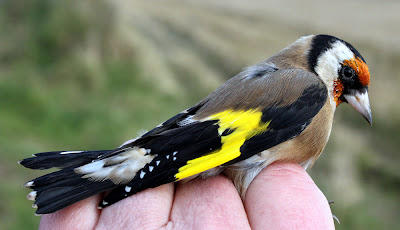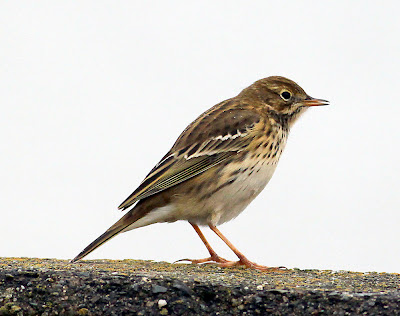Although Sunday morning saw my third ringing session in three days out on Rawcliffe Moss, the morning was somewhat spoiled by an early and stubborn mist. The figure three entered the equation again when I caught the third “control” in three days, this time a Chaffinch ringed elsewhere - ring number Y867191.
I set off from home to starry skies through Hambleton village and then alongside the River Wyre with just a hint of mist, but once out on the moss the dank air made for a more fog like substance, a scenario which limited any early bird arrivals. The at-dawn catch involved one Blackbird only, the few other thrushes in the vicinity of the nets a single Fieldfare, 2 Redwing and a couple more Blackbirds, all of which escaped captivity.
Catching didn’t start really until after 0830 when the mist finally cleared to reveal a bright blue sky as from the north and west finches began to appear and call from high overhead, some of them lingering briefly in the plantation.
22 birds of 7 species caught today: 10 Chaffinch, 6 Lesser Redpoll, 2 Goldcrest, 1 Blackbird, 1 Reed Bunting, 1 Coal Tit, 1 Robin.
Reed Bunting- juvenile female
Goldcrest - juvenile male
Lesser Redpoll -juvenile female
Lesser Redpolls were much in evidence again today, with a minimum of 40 birds moving through the site in small groups between 0815 and 1045 when I left. Other high-flyers heading south: 4+ Siskin, 50+ Chaffinch, 10+ Meadow Pipit, 2 Pied Wagtail.
Following a blog comment on Saturday it seems that Lesser Redpoll Y310191 caught here on Friday morning had been ringed in a Worcestershire garden in March this year by “Napper”, Another Bird Blog’s latest follower. In contrast, it could be some weeks for me to hear about yesterday’s Belgian ringed bird or today’s Chaffinch, and while it’s good to see how efficient the Internet is in this instance it isn’t a means of by-passing the proper method. This works by ringers regularly sending their data files into the BTO, who process information about the millions of birds handled through the UK and other ringing schemes in order to match the records of original ringing details to those of recovered and recaptured birds.
Below is today’s recaptured female Chaffinch Y867191, not a ring used here or on other local sites, so a bird marked elsewhere in the UK. The rounded, broad tail and strongly demarcated tertial feathers show the bird to be an adult, i.e. born before this calendar year.
Chaffinch- adult female
Chaffinch - adult female
Other birds today: Barn Owl hunting at dawn, 3 Tawny Owls, 4 Snipe, 2 Buzzard, 1 Kestrel, 2 Jay.
This week Another Bird Blog is linking with Stewart's Photo Gallery and Anni who’d rather be birding anytime. If you would sooner be birding most of the time, log in here for the latest news and views.





















































.jpeg)




.jpg)












